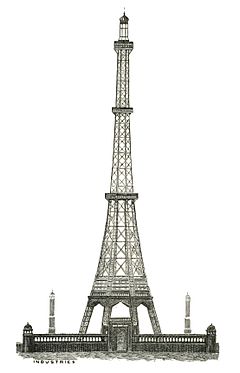Watkin's Tower
| Watkin's Tower | |
|---|---|

Proposed design of Watkin's Tower
|
|
| General information | |
| Status | Never completed |
| Type | Observation tower |
| Location | Wembley, London, UK |
| Coordinates | 51°33′20″N 0°16′46″W / 51.55556°N 0.27944°WCoordinates: 51°33′20″N 0°16′46″W / 51.55556°N 0.27944°W |
| Construction started | 1891 |
| Completed | 1894 |
| Opening | May 1896 |
| Demolished | 1907 |
| Height | |
| Antenna spire | Original: 358 m (1,175 ft) Finally: ~47 m (154 ft) |
| Design and construction | |
| Architect | Sir Benjamin Baker |
| Developer | Stewart, MacLaren and Dunn |
| Main contractor | Metropolitan Tower Construction Company |
| References | |
Watkin's Tower was a partially completed iron lattice tower in Wembley Park, London, England, UK. Its construction was an ambitious project to create a 358-metre (1,175 ft)-high visitor attraction in Wembley Park to the north of the city, led by the railway entrepreneur Sir Edward Watkin. Marketed as the "Great Tower of London", it was designed to surpass the height of the Eiffel Tower in Paris. The tower was never completed and it was demolished in 1907. The site of the tower is now occupied by the English national football ground, Wembley Stadium.
Numerous names were given to the tower during its planning, construction and legacy. These include Watkin's Tower,Watkin's Folly, the Wembley Park Tower, the Wembley Tower, the Metropolitan Tower, and the London Stump.
Sir Edward Watkin (1819–1901) was a British Member of Parliament and railway entrepreneur, noted for being chairman of nine different British railway companies. He was an ambitious visionary, and presided over large-scale railway engineering projects to fulfil his business aspirations. He began work on the construction of a channel tunnel under the English Channel, with the aim of connecting his lines to the railway network in France, and successfully opened the Great Central Main Line, a purpose-built high-speed railway line which was designed to accommodate the larger continental European trains which would cross into Britain from France. Although the channel tunnel project failed in 1881, Watkin remained a driven innovator, inspired by grand schemes which could augment his railway empire.
...
Wikipedia
